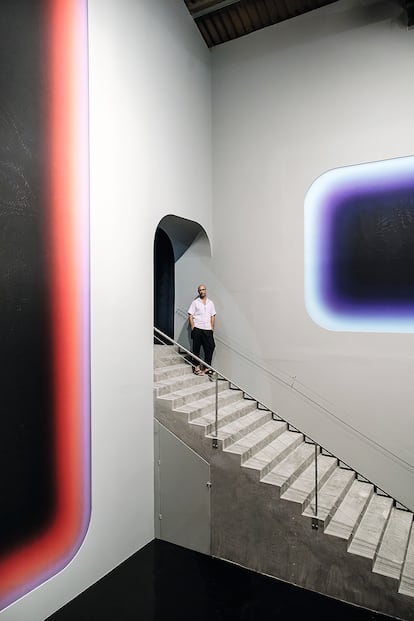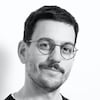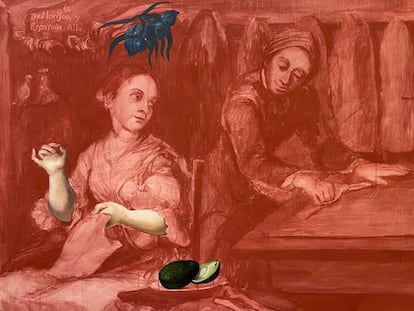‘In my twenties, I just wanted to drink and smoke’: Jonny Niesche, the artist who saw the benefits of taking up painting at 30
The Australian creator is presenting his greatest work, in both ambition and size, at the Nave Salinas space on the island of Ibiza

It’s hard to know whether you are inside the Death Star, in a 1970s cosmetics ad, on a space odyssey about to buy an iPhone at the first Apple Store on Jupiter, or are pondering Kant’s concept of the sublime — or all of these at the same time. The only certainty is that you are in the Nave Salinas gallery in Ibiza, or, in other words, in certain confines of the head of Jonny Niesche (Sydney, 51 years old), the minimalist art painter who will be occupying this 600-square-meter venue until the end of October.
“They proposed that I create a Jonny universe,” says the artist triumphally, seated on the steps of the exhibition room, wearing a white shirt and an ever-present smile on his face. And he points to the outcome: two 10-meter-high vertical squares and a 20-meter-high horizontal one, black and shaped like a windshield, whose curves, reminiscent of 1970s science fiction, feature a myriad of shades of countless colors. It is as if Mark Rothko had been commissioned to design a Flash Gordon comic book. The project, called _ness, reflects a very specific spiritual orientation. “I basically wanted to try and create a space that kind of shut out all the noise of the everyday; a space where I could have clearer thoughts. A space which is bit meditative but has kind of all different types of links into different aspects of things that have interested me and have influenced my art making.”
The almost Niemeyerian immensity of the works confers on the project an unmistakably incorporeal entity; it makes you feel diminutive, more of a concept than a human being. “The beauty of feeling small resonates to the beauty of being connected to the universe, and the sublime,” explains Niesche, maybe because one cannot be born with that surname to talk about football. “The idea is to make you feel like you’re inside a floating temple in the cosmos, where you can meditate,” he muses. This Buddhist approach, in which one isolates oneself from the world to find the cosmos within oneself, is captured literally in his work. “They seem like windows to outer space through a spaceship,” says Niesche. “But if you go and get close enough you will see your reflection on the surface.” In the background, incidentally, you can hear the sound of the black hole at the center of the Perseus Cluster, as captured by NASA at the time.
The spiritual aspect is as universal as outer space. The aesthetic approach, more specifically, relates directly to the life of Niesche, who grew up in Sydney in the 1970s, watched Star Wars and 2001, was bored by the reflective surfaces of the supermarket aisles with their beauty products, especially lipstick. And of course, he evolved with the most influential sticker of the 20th century: David Bowie. “I was obsessed with him, with Blondie and with glam rock in general,” he explains. “Can you see that red thing over there?” he says pointing at the walls. “It’s exactly Bowie’s eyeshadow on the cover of Aladdin Sane. I literally selected it with the computer and replicated it.”
_ness is certainly beautiful — that’s the very least that can be said about it. It is pleasing on the eye, and one moment inside the exhibition beckons you to spend another. In this sense, it is invariably a masterpiece by Niesche, who has been creating art for 20 years and a few more years, detached from the thanklessness of life. “I started making art in my 30s. So before that, I lived in New York, and I was playing in hardcore rock bands,” he explains, in a very un-Zen-like change of direction. “Before this I’d been in Los Angeles until I had enough. I’d gone there with my girlfriend from Australia with just my guitar on my back. When I went to New York, a number of fairly well-known hardcore musicians asked me if I wanted to play with them. I said: ‘Okay.’ I didn’t like the genre very much, but I ended up being a singer and songwriter in several groups, and I recorded in several studios. After 10 years of that, I got married to my wife and I was very fed up, I was very unhappy. I told myself: ‘Let’s go back to Australia’. Once I was there, I didn’t quite know what to do with my life, so I became a painter,” he continues.
Clarification: he did not become a palette artist painter, but a painter of walls, surfaces and ceilings. A broad-brush painter.
“When I went back to Australia, my parents said, ‘Hey, do you want to fix up the house because we need to sell it? I’m like, ‘sure.’ So I rendered the walls, sanded the floorboards, painted it. When I was done I said: ‘Why don’t I also do the For Sale sign?’ So I got some spray paint and moved it around. And the house sold! So then I went and got three canvases, I did the spray paints on the canvases and took them to a gallery because I knew someone from school that had a gallery they’d sold straight away. So then I went and made some more paintings,” he recalls. Drawing had been an obsession in his childhood, but perhaps not so much painting. “We had a Chilean family friend, and he taught me to draw; He was obsessed with Da Vinci and he taught me to draw and how to shade and render and color. And at school, I won the art prize every year. I loved art, but it was by the time I became, like, 14 or 15, I became more interested in girls, music and drugs.”
That first batch of works paved the way for him. “I became successful quickly, just in a very small gallery way. And a close friend of mine told me: ‘You need to go to art school. Your paintings are pretty, but you don’t know what you’re doing, but you have some kind of talent, you should go to art school and learn what your place is in history and in the future of art.”
And that’s what he did. At 30 he enrolled at the Sydney College of Arts and, after three years of distinction, was awarded a scholarship to the Academy of Fine Arts in Vienna. “That was also a great experience. If I’d done it in my twenties, I probably would’ve just wanted to drink and paint and drink and smoke a joint and paint and whatever. Different attitude with age, I think.”
This is not the whole story that _ness tells, but it is the whole story that is in _ness. As Bowie’s mascara is on the curved edges of Logan’s Run (1976) canvases, among thousands of other colors. It is beautiful, like everything Niesche has ever painted, but it also has something more to it. He smiles again here. “It’s really a place to connect to shut out the outer world outside and to connect with whatever inner world,” he concludes emphatically.
Sign up for our weekly newsletter to get more English-language news coverage from EL PAÍS USA Edition
Tu suscripción se está usando en otro dispositivo
¿Quieres añadir otro usuario a tu suscripción?
Si continúas leyendo en este dispositivo, no se podrá leer en el otro.
FlechaTu suscripción se está usando en otro dispositivo y solo puedes acceder a EL PAÍS desde un dispositivo a la vez.
Si quieres compartir tu cuenta, cambia tu suscripción a la modalidad Premium, así podrás añadir otro usuario. Cada uno accederá con su propia cuenta de email, lo que os permitirá personalizar vuestra experiencia en EL PAÍS.
¿Tienes una suscripción de empresa? Accede aquí para contratar más cuentas.
En el caso de no saber quién está usando tu cuenta, te recomendamos cambiar tu contraseña aquí.
Si decides continuar compartiendo tu cuenta, este mensaje se mostrará en tu dispositivo y en el de la otra persona que está usando tu cuenta de forma indefinida, afectando a tu experiencia de lectura. Puedes consultar aquí los términos y condiciones de la suscripción digital.
More information
Últimas noticias
Most viewed
- Sinaloa Cartel war is taking its toll on Los Chapitos
- Reinhard Genzel, Nobel laureate in physics: ‘One-minute videos will never give you the truth’
- Oona Chaplin: ‘I told James Cameron that I was living in a treehouse and starting a permaculture project with a friend’
- Why the price of coffee has skyrocketed: from Brazilian plantations to specialty coffee houses
- David King, chemist: ‘There are scientists studying how to cool the planet; nobody should stop these experiments from happening’










































